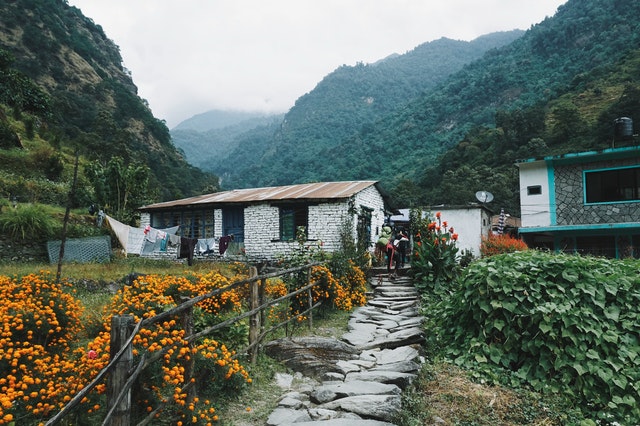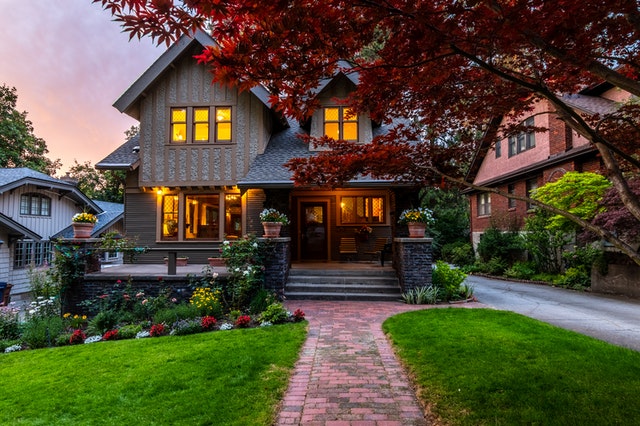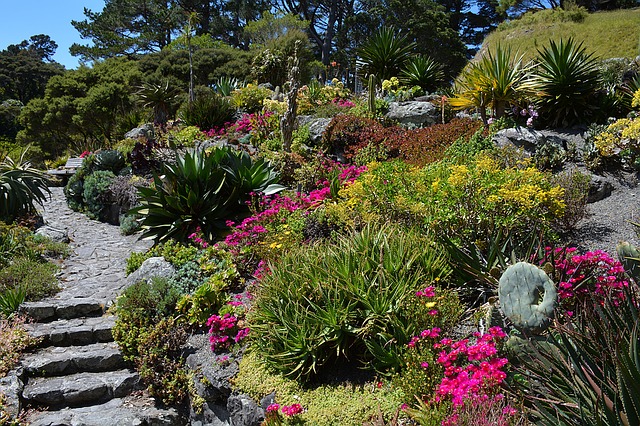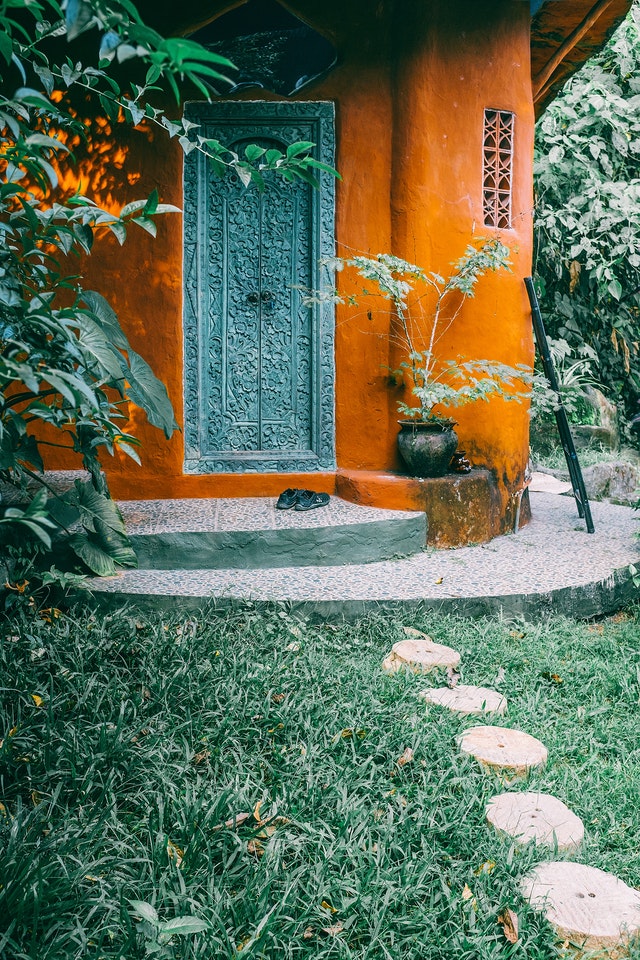In this chapter, we will look at creating good bones for your landscape, and we’ll explore options for paths and walkways, walls and fences, and hedges and screens of plants. The next chapter will go on to address structures.
Paths and Walkways
Paths are essential on most properties. They get you form one place to another, enable the mailman to find your front door, allow you to push cartloads of compost to the beds and borders where you need it, and show visitors how to move through your garden to enjoy its beauty without getting their feet wet or muddy. Paths connect house and landscape into a unified property. They link the house to the street and all the outdoor spaces you use—the garage, a shed, a gazebo, a patio. From the routes you normally take to reach these places. You can start to build a pattern with pats.
Paths move you through the landscape both physically, as you walk on them, and mentally, as your eyes follow their lines across the land. Try to put in the fewest paths you need to get from place to place. You don’t want to carve up your property with a maze of paths running here, there, and every-where. Instead, leave the space in bigger chunks and use it for garden beds and borders, or for lawn or other plantings. Whether your landscaping plans involve renovating an existing garden or starting a new one, it pays to understand the characteristics of your property before you begin. You will want to construct pathways and other structural features where they will serve their purpose most effectively and play a visually pleasing role in the overall design, of course, but you also need to take into account the land itself.
You need know particularly where paths are concerned, where water collects after heavy rain, where ice is likely to form, and where snow lingers in spring. It’s also wise to find out the path water follows when it runs off during a storm.
It’s best to avoid putting paths or walkways in poorly drained locations. Water will puddle up on the paths during heavy rain and freeze over in winter, making walking difficult in both cases. If you have no alternative to making a walkway in a wet spot, you will need to either install drainage tiles or pipes underground or build a raised boardwalk to keep your feet dry.
Where to put paths
When you moved into your house, it probably already ready had a walkway from the street or driveway to the front door. But there are numerous other places where paths are useful. You will need paths to link different parts of the landscape. You’ll also need to have access to beds and borders to maintain the plants; you’ll have put out the trash, and you’ll need to get to the garage (if it’s not attached to the house) and to wherever you park your car in the driveway. A path can lead to a gazebo, arbor, or other outdoor structure; to a swimming pool or pond; to a bench or swing; or to a special area for children’s play or sports. You might want a path that leads past a piece of art, a birdbath, a sundial, or some other ornament. A path can lead past garden beds and borders (an edging of bricks lay flat and flush with the ground makes a handy mowing strip so you won’t have to edge the path). Look for places people naturally walk, where the grass is worn from foot traffic. There might be a shortcut you habitually take across the lawn to get to your car, for instance. You probably need paths in these places, too. If these tracks don’t fit well into your design, you can put in a few less noticeable stepping-stones instead of a path to save the grass. If your garden is formal, you will want to create a grid of straight paths that are smooth and level. If your property slopes at an angle of 30 degrees or more, you will need to build a series of terraces in which to garden, in order to maintain the straight lines and sharp edges of a formal design. You might include a path running horizontally across the face of the hillside to enhance the controlled, contained look of the garden.
Paths in an informal garden can wind and curve as they meander through the landscape, following the line of a bed or border and tracing gentle undulations in the terrain, where steps are not needed. Paths that twist and tum bring a touch of mystery to the garden, and a sense of discovery you never know what you will find around the next bend. Winding paths also make a small garden feel bigger. Even in an informal garden, though, you will probably want to make some paths straight. Routes to destinations you need to reach in a timely manner, such as those to the garage or the trash bin, for instance, are usually best laid straight to their goals.
On the other hand, a path that leads to a shady bench or a secluded pool, or past a piece of sculpture or a breath taking specimen tree, can meander a bit to allow strollers to take in more of the garden along the way. You will walk more slowly on a winding path, and you will have more time to look around you.
The surface materials of a path also affect the speed at which you will traverse it. Rough, uneven surfaces demand more care of the walker. Smoother surfaces encourage a speedier pace. You can factor ease and speed of travel into your path planning. And you can even use surface pavements to manipulate how fast people walk in your landscape Switching from smooth, even flagstone stepping-stones to rougher fieldstone as the path approaches a garden feature will cause strollers to slow down to notice the feature. Just don’t make the pavement so uneven that people will need to look down at their feel in order not to trip.
You can also use different path surfaces in different parts of the landscape to call attention to transitions from one area to another, as for example, between one garden room and the next, or between a sunny flower border and a shady woodland garden. In Japanese gardens, different pavements are often used to denote different part of the landscape and to highlight specimen plants and carefully orchestrated views.
Paths should be wide enough to comfortably accommodate the people and accessories passing over them, but they need not all be the same width A primary path, one that leads to an important destination, such as the front door, the swimming pool, or into the garden should be 3 to 4 wide so two people can comfortably walk side by side. You might even prefer the walk to the front door to be wider still—4 or 5 feet—to give it maximum importance and also to visually balance the volume of the house Also take into account whether you will need to push a lawn mower, garden cart, or baby stroller along the path—such needs help determine the best pavement material for the path.
Secondary paths that allow you to get behind beds and borders to maintain the plants, fill birdfeeders, or find your way to a hidden hammock should be narrower than the primary paths; 2to3 feet is usually sufficient.
Consider, always, the comfort and safety of those who will use the paths. Make all paths a bit wider where they curve. If the path will climb a slope, plan to add steps if the grade exceeds 4 or 5 present. A path used often by young children (to reach a play area, for instance) needs a soft surface. Where older people or others not always surf-footed will walk, avoid using surface materials—such as wood and smooth slate—that become slippery when they’re wet. Finally, keep paths at least 2 feet away from the foundation of the house, walls, hedges, and large trees.
Path Styles
Paths look best when they are planned to blend in with the house and other elements of the landscape. Lots of different materials will serve to surface a path—some formal, other informal; some hard, others soft. Your goal is to choose a path style that will work with the house and look at home on your property.
One way to connect paths to the look of the house is to repeat some of the same materials used on the house and elsewhere in the landscape. If your house is brick, consider using brick for the main paths. If you have a flagstone patio, you can also use flagstone on your paths. If your house is sided with wood shingles, look for gravel, field-stone, or concrete pavers of a similar color. If your house is stuccoed, you could paths with light sandstone of a similar hue. In a woodland garden, surface paths with shredded bark or another woodsy material to keep them unobtrusive and let the soft colors of your shade-tolerant wildflowers and bulbs shine through.
Brick, flagstone, and concrete pavers all can work beautifully for paving paths in formal gardens. Tile creates a Mediterranean look. Gravel comes in variety of colors and is versatile in its applications, but it is an especially good choice for paths in a rock garden or a desert garden. You can get creative with paths, too, and make mosaics of tile, pebbles, marbles, or even pieces of broken flowerpots or old dishes set in cement. You can even cast your own stepping-stones (kits are available) and memorialize children’s footprints, favourite sayings, important dates, and other items with personal meanings.
Surface Materials
Path materials are either hard and solid or soft and yielding underfoot. Hard surfaces—brick, flagstone, and concrete (poured or in the form of individual paving blocks)—work well in formal gardens. They, along with less-formal fieldstone, are expensive and time-consuming to install, but they are durable, hold up well under traffic, are reasonably permanent, and don’t require a lot of maintenance. Soft surfaces—grave, pebbles. Wood chips, shredded bark, pine needles, and grass or groundcovers—are inherently informal, for the most part. They are inexpensive and quick and easy to install, but they need periodic maintenance and replenishment. Gravel and pebbles scatter and work their way down into the ground over time. Mulches, wood chips, and pine needles decompose. Grass has to be mowed and ground-covers weeded, at least once in a while. It’s also difficult to push a wheelbarrow over a soft-surface path. Stepping-stones have a hard surface, but they are set into the laws or a base of loose stones; they are really a category of their own.
Consider your site as well as your house when choosing path materials such practical considerations as the terrain and the amount of traffic the path will bear need to be taken into account. If you live in a rainy climate, a hard-surfaced path in a low spot is an invitation to standing puddles after rain. A porous, loose surface of gravel or mulch will allow rainwater to soak into the ground rather than run off and is a better choice. But on a slope. A loose surface such as wood chips or pebbles will be likely to wash downhill during heavy rains. A much-travelled path between the house and garage will provide the surest, safest footing if it is paved with a smooth, hard material.
Any path needs to be well prepared before the surface is laid if it’s to function well over time. Hard surfaces are best laid on a base of gravel and sand to ensure good drainage and stability the last thing you need is a large, lingering puddle or a sheet of ice in the middle of the walkway. Stepping-stones need to be set into the ground so that their faces are even with the surface. When just set on top of the ground, they can tip over if you step on their edges. Even a simple path of shredded bark will stay in place better if you prepare the ground first and install an edging. No matter what kind of surface you use, try to make the path very slightly higher in the center (about ¼ inch) and slightly lower at the edges. So water will not collect on the path.
Here is a rundown of possible path materials and their applications.





